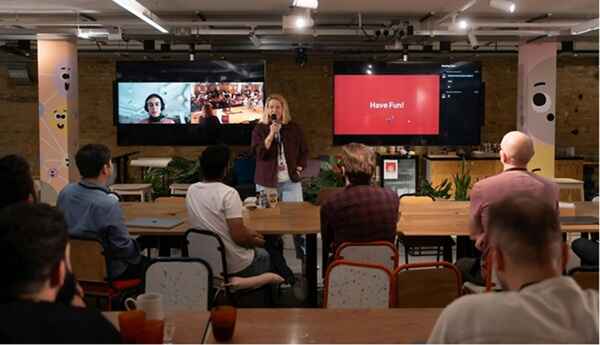Training’s no longer about stuffy manuals or one-size-fits-all seminars—it’s a dynamic pulse, shaping how teams grow, creators share, and learners thrive. A modern training platform is the engine, turning raw knowledge into skills that stick, whether for a company upskilling coders or a solo guru teaching pottery. It’s not just tech; it’s a bridge—connecting curiosity to mastery with tools that flex for real life.
The right features don’t just make learning easier—they make it irresistible, sparking engagement and impact in a world that moves fast.

The Core of a Great System
More companies today are turning to learning management systems (LMS) as one of the most effective modern solutions for organizing, delivering, and tracking employee training and development. Picking the best LMS software means finding a platform that’s intuitive yet powerful, like a Swiss Army knife for learning.
It should let trainers—say, a sales coach or a yoga instructor—build courses without struggling with code. Drag-and-drop builders, video uploads, and quiz templates are non-negotiable, letting anyone craft a lesson that pops, from onboarding reps to teaching mindfulness. It’s not about bells and whistles; it’s about flow—making creation as seamless as teaching in person, so the focus stays on content, not tech hiccups.
Mobile-First Flexibility
Learners aren’t chained to desks—they’re on buses, couches, or coffee breaks. A top platform goes where they go, with a mobile app or browser that’s slick, not clunky. Picture a nurse swiping through a compliance module between shifts or a freelancer catching a marketing tip over lunch.
Offline access seals the deal—download a video, study on a plane, sync later. It’s not just access; it’s freedom—learning that bends to life’s rhythm, keeping momentum high no matter where you are.
Engagement That Hooks
A platform’s only as good as its pull—nobody wants to slog through a dull course. Gamification’s a must: badges for hitting milestones, points for quizzes, or leaderboards to spark friendly rivalry.
Think of a coder earning a “Bug Slayer” badge for nailing a tough module—it’s not kid stuff; it’s psychology, nudging learners to keep going. Interactive bits—polls, scenarios, or quick debates—turn passive watching into active doing. It’s not fluff; it’s fire—keeping eyes glued and brains buzzing.
Personalization for Impact
One-size-fits-all training flops—learners need paths that fit. A great platform tailors the ride: maybe it suggests a negotiation course for a rookie salesperson or skips basics for a veteran chef.
Smart algorithms can nudge—offer a follow-up module based on quiz misses or flag a video a learner loved. Or let trainers set custom tracks: HR gets compliance, devs get APIs. It’s not fancy; it’s focus—making every click feel like it’s for you, boosting stickiness and skill.
Collaboration as a Catalyst
Learning is social—platforms should lean into that. Forums, group chats, or project spaces let learners swap ideas, like marketers brainstorming ad copy or nurses sharing triage tips.
A trainer might host a live Q&A, fielding questions as they fly, or spark a thread on leadership hacks. It’s not noise; it’s network—building a vibe where learners lift each other, turning a course into a crew. That connection’s the glue, making skills land deeper than solo study ever could.
Analytics That Empower
Trainers need a window into what’s working—great platforms deliver. Dashboards should show who’s soaring or stuck—say, a rep who’s aced sales tactics but fumbled analytics. Learners get their own view: progress bars, skill gaps, and next steps.
For bosses, it’s gold—spot a team’s weak spot, like shaky product knowledge, and pivot fast. It’s not spying; it’s steering—clear insights that let trainers tweak, learners grow, and goals align, all without guesswork.
Seamless Integration
No platform’s an island—it needs to play nice with other tools. Sync with HR systems to track onboarding, plug into Slack for quick nudges, or hook up with Zoom for live classes.
A salesperson might log a deal in CRM, then see a related training pop up. Or a creator’s course could pull payments through Stripe, no fuss. It’s not techy; it’s tidy—knitting your ecosystem so training feels like part of the flow, not a side hustle that eats your day.
Support That Saves
Even the best LMS software needs a human touch—learners and trainers will hit snags. A top platform offers help that’s fast, not canned: live chat for a stuck admin, guides for a learner lost in settings, or webinars to level up course design.
Think of a manager prepping a team rollout—clear support means no delays, no rage-quits. It’s not an afterthought; it’s armor, backing users so they focus on learning, not fighting the system, keeping the whole operation smooth.

The Platform Payoff
The best modern training platforms aren’t just tools—they’re a spark, turning training into transformation. Mobile reach, personal paths, social vibes, and sharp data make learning stick, whether it’s a startup sharpening skills or a creator sharing art. It’s not about features for show; it’s about impact—hooking learners, empowering trainers, and tying knowledge to action. Pick a platform with these must-haves, and you’re not just teaching—you’re igniting, building skills that last in a world that’s always shifting.